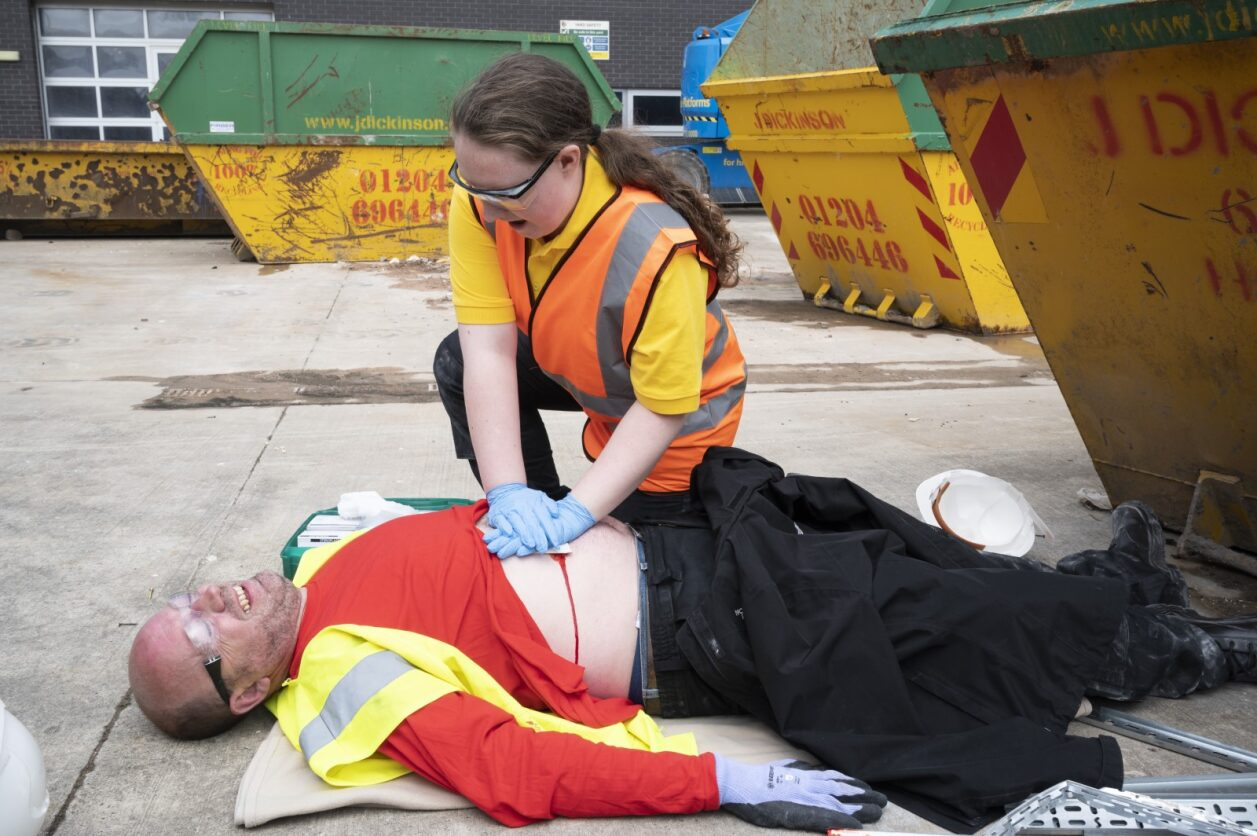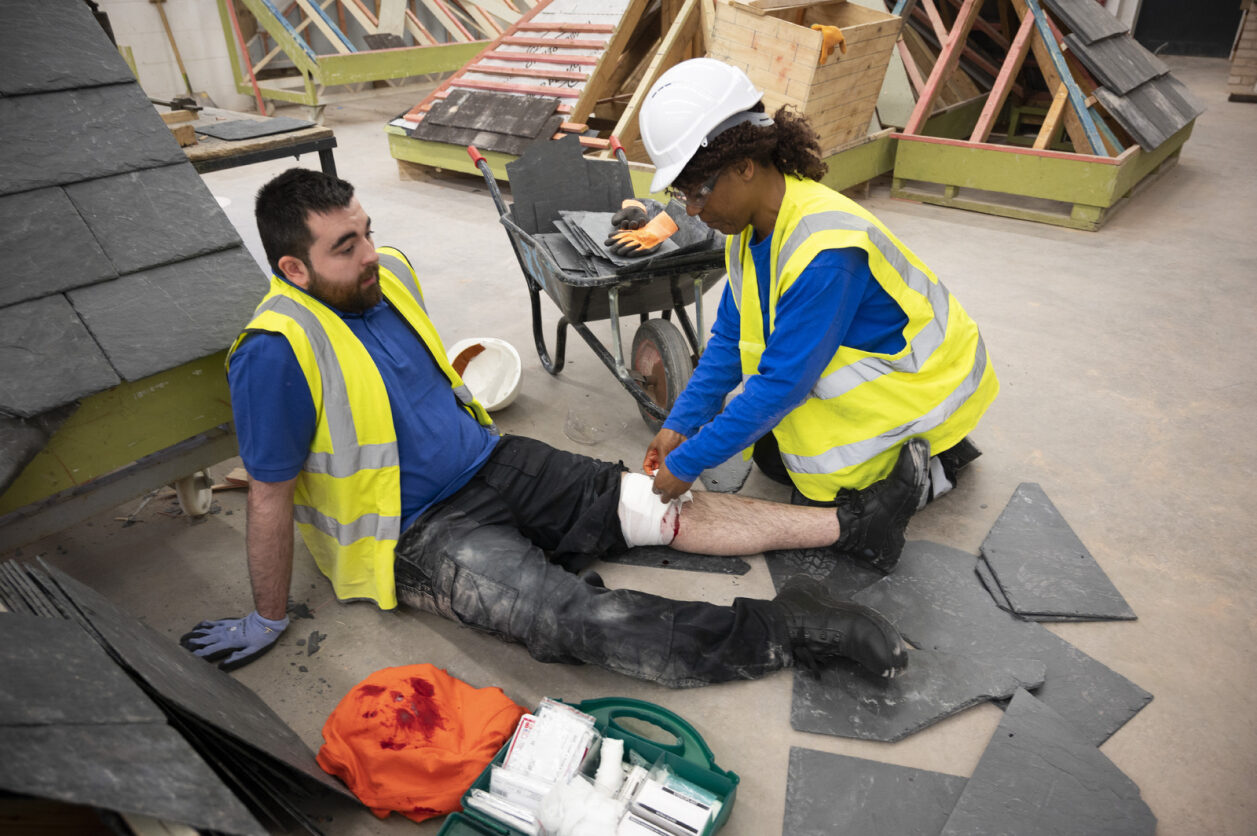Life-threatening bleeding in the workplace is an unlikely situation. Whether you work in an office or on a construction site, there should be procedures in place to help prevent a serious situation from ever occurring.
However, accidents happen both in and out of workplaces, so training your employees in first aid at work to learn how to deal with life-threatening bleeding is important. If a major incident were to occur, training in life-threatening bleeding should give your teams the skills and confidence to help, even before the emergency services arrive.
In this blog we explain what exactly is meant by life-threatening bleeding, the latest Health and Safety Executive (HSE) guidance, and why we now include it on Red Cross Training first aid at work courses.
What is life-threatening bleeding?
Life-threatening bleeding is associated with a casualty who has sustained major trauma injuries, causing them to lose a significant amount of blood.
Even if an injury looks serious, it is only classed as a life-threatening bleed if it is:
- Severe: obvious heavy bleeding, usually free flowing but not necessarily pumping.
- Sustained: the bleeding continues unless effectively managed.
- Uncontrolled: the wound continues to bleed despite initial treatment.

Note: This image does not depict the severity of someone suffering a life-threatening bleed, but rather gives an indication of first aiders helping if someone has sustained an injury.
How does life-threatening bleeding differ from other forms of bleeding?
Since many workplace mishaps are relatively minor, in most cases you can deal with a minor injury by simply cleaning and covering it with a plaster. If the wound is more severe, a heavy bleed can normally be managed by applying direct pressure and a bandage will maintain that pressure while the casualty is transported to hospital for further assessment if necessary.
A life-threatening bleed is unlikely to occur in a workplace environment, but if there is an incident, it’s important to act fast as the casualty will be losing large amounts of blood quickly.
Imagining the level of bleeding as a spectrum is helpful in knowing how to act in an emergency:
- For a splinter or graze, the only action necessary might be making sure the wound is cleaned.
- For a nosebleed/anything up to a heavy bleed, you need to apply direct pressure.
- If pressure isn’t working and the bleeding continues, this could potentially be life-threatening. This is where the following first aid training comes in.
What do you do if someone is suffering from life-threatening bleeding?
Life-threatening bleeding is associated with a casualty who has sustained major trauma injuries, causing them to lose a significant amount of blood. In almost every situation faced by members of the public, direct pressure should be the initial key intervention to help control bleeding.
If a bleed is deemed to be sustained and uncontrollable – that is to say if direct pressure is not serving to control the blood loss – then further intervention should be considered. It is possible for a casualty to bleed out very quickly. When completing a primary survey in major trauma, life-threatening bleeding should be assessed and managed promptly before moving onto the airway and breathing checks. This approach, where bleeding takes priority, is sometimes referred to as C-ABC, which stands for catastrophic bleeding, airway, breathing and circulation.
The casualty is highly likely to suffer from shock as the significant blood loss causes their blood pressure to drop and vital organs begin to shut down. This should be considered as part of the management of any life-threatening bleed.
Once an initial assessment is complete, and if direct pressure is not sufficient to manage the blood loss, as a first aider you might need to use a PAcT kit to deal with the bleeding before emergency services arrive. This contains haemostatic dressings for wound packing and tourniquets to restrict the blood flow in a limb.
 Note: This image does not depict the severity of someone suffering a life-threatening bleed, but rather gives an indication of first aiders helping if someone has sustained an injury.
Note: This image does not depict the severity of someone suffering a life-threatening bleed, but rather gives an indication of first aiders helping if someone has sustained an injury.
What is a PAcT kit?
PAcT stands for public access trauma kit and these can be located in publicly accessible locations such as city centres, shopping centres, concert venues, sports stadia or workplaces. You may have seen PAcT kits in public places where they are designed to be used by members of the public in an emergency situation.
If a first aid needs assessment has identified the need for such equipment in a workplace, it is desirable that first aiders would be trained in its use, although the kit does contain full instructions and is designed to be used by members of the public even without training. Contents may vary, so first aiders are advised to familiarise themselves with the equipment available to them.
PAcT kits typically include items such as:
- gloves
- face shields
- wound dressings
- haemostatic dressings
- tourniquets
- instructions/guidance leaflets.
What is a haemostatic dressing?
Haemostatic dressings work by promoting local site clotting within 45-90 seconds of being applied to the wound. They can be used to pack open and severely bleeding wounds and are particularly useful for wounds where direct pressure cannot be applied successfully, such as necks or armpits.
On our First Aid at Work and First Aid at Work Requalification courses learners have the opportunity to practise some of the skills required to effectively pack a wound such as using the Z-fold technique, while in the safety of a classroom environment. They can also get answers to some common questions and misconceptions from our skilled, professional trainers.
What is a tourniquet?
Tourniquets are used on limb injuries only to cut off blood circulation above the site of injury, so that blood loss is limited where it cannot be controlled by other means. They support a holistic approach to managing bleeding and wounds and would potentially be used when other actions are not working effectively enough.
Even when they are applied correctly, tourniquets may cause further injury and will usually be very painful indeed for the casualty. This is why we would not use a tourniquet unless it was really necessary.
While the majority of injuries would never warrant using a tourniquet, it's helpful to have had a chance to familiarise yourself with how they are used. On our First Aid at Work and First Aid at Work Requalification courses, learners have the opportunity to safely secure a tourniquet around a simulated limb using real tourniquets and classroom training tools.
Why is life-threatening bleeding on Red Cross Training first aid at work courses?
In line with recently updated HSE guidance, employers may need to consider how their first aid training provider includes training on life-threatening bleeding, should their first aid needs assessment indicate they need to train first aiders in this topic.
All British Red Cross workplace first aid training covers bleeding, applying bandages, minor wounds and nose bleeds.
Our three-day First Aid at Work and two-day First Aid at Work Requalification training courses are intended for more high-risk workplaces or circumstances such as construction or manufacturing. All risk assessment should be in place anyway, so you would hope to never see life-threatening bleeding in these situations.
By the end of these first aid courses, you will have the confidence and skills to know how to help someone who is suffering life-threatening bleeding. This includes:
- Understanding the principles of managing a life-threatening bleed
- Treating someone who has a life-threatening bleed by:
1. applying pressure
2. calling 999
3. appropriately managing the bleed with further intervention, such as haemostatic dressings or a tourniquet.
First aid is a last resort but it’s important for your employees to know how to act if a major incident were to occur, whether in the workplace or in their daily lives, where they may need to help a friend or family member. As a first aider, there is a great deal of value in knowing how serious the situation is. Our training includes helping first aiders feel equipped to make those urgent decisions.
Topics: First Aid
